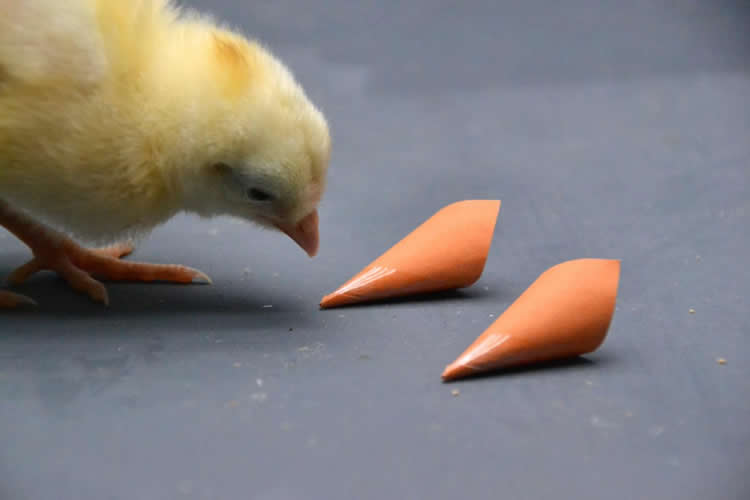Summary: According to researchers, color vision is vital for chickens to find good food and the right mating partner.
Source: Lund University.
New research discoveries at Lund University in Sweden show that in almost any lighting conditions, colour vision is crucial for chickens – and probably other birds as well – in order to find good food that is ripe to eat and identify high quality partners to mate with.
The researchers have established that chickens – just like people – have colour constancy. For birds, this means that they, in different environments and under different lighting conditions, recognise the colour of, for instance, berries and can thereby distinguish those that are ripe from those that are not. Without colour constancy, they would not be able to rely on their colour vision – they would simply see the berries in different colours as the light changed. They would certainly also not be able to recognise their own kind of species.
The results were achieved by the researchers from training chickens. Initially, the chickens were kept in an environment with white light and had access to containers marked in three different colours: red, yellow and orange. Only by selecting the orange container would the birds receive food. The researchers then studied which container the chickens selected when the light in the room was switched to different shades of red. The results showed that the chickens continued to select the orange container.

“We studied many different lighting conditions to find out how big the changes in light could be without the chickens losing their colour constancy. This type of study has never been done before”, says Peter Olsson, biologist and one of the researchers of the world-leading Lund Vision Group at the Faculty of Science at Lund University.
By using a mathematical model, the researchers calculated how big the changes in light are inside the chickens’ eyes. The same model can be used on other animals and thereby allow researchers for the first time to compare the colour constancy of chickens and birds to the colour constancy ability in other animals.
Color constancy helps birds find the right food and the right partner.
“We can also compare the chickens’ colour constancy ability in the laboratory to the light changes they and other birds experience in nature, such as how the lighting conditions differ in the woods from in an open field. Our results show that they are able to maintain their colour constancy under greater changes in light in the laboratory than when experiencing those that occur in nature”, says Peter Olsson.
The study was conducted by Peter Olsson together with his colleagues at Lund University and Bristol University. The article is published in the scientific journal Proceedings of the Royal Society B.
Source: Kathleen Haughney – Lund University
Image Source: This NeuroscienceNews.com image is credited to Lund University / C. Schubert.
Video Source: The video is credited to Lund University.
Original Research: Abstract for “Quantitative studies of animal colour constancy: using the chicken as model” by Peter Olsson, David Wilby, and Almut Kelber in Proceedings of the Royal Society B. Published online May 11 2016 doi:10.1098/rspb.2016.0411
[cbtabs][cbtab title=”MLA”]Lund University. “Color Vision Helps Birds Find Good Food and the Right Partner.” NeuroscienceNews. NeuroscienceNews, 17 June 2016.
<https://neurosciencenews.com/food-mating-color-vision-4507/>.[/cbtab][cbtab title=”Lund University”]Lund University. (2016, June 17). Color Vision Helps Birds Find Good Food and the Right Partner. NeuroscienceNews. Retrieved June 17, 2016 from https://neurosciencenews.com/food-mating-color-vision-4507/[/cbtab][cbtab title=”Chicago”]Lund University. “Color Vision Helps Birds Find Good Food and the Right Partner.” https://neurosciencenews.com/food-mating-color-vision-4507/ (accessed June 17, 2016).[/cbtab][/cbtabs]
Abstract
Quantitative studies of animal colour constancy: using the chicken as model
Colour constancy is the capacity of visual systems to keep colour perception constant despite changes in the illumination spectrum. Colour constancy has been tested extensively in humans and has also been described in many animals. In humans, colour constancy is often studied quantitatively, but besides humans, this has only been done for the goldfish and the honeybee. In this study, we quantified colour constancy in the chicken by training the birds in a colour discrimination task and testing them in changed illumination spectra to find the largest illumination change in which they were able to remain colour-constant. We used the receptor noise limited model for animal colour vision to quantify the illumination changes, and found that colour constancy performance depended on the difference between the colours used in the discrimination task, the training procedure and the time the chickens were allowed to adapt to a new illumination before making a choice. We analysed literature data on goldfish and honeybee colour constancy with the same method and found that chickens can compensate for larger illumination changes than both. We suggest that future studies on colour constancy in non-human animals could use a similar approach to allow for comparison between species and populations.
“Quantitative studies of animal colour constancy: using the chicken as model” by Peter Olsson, David Wilby, and Almut Kelber in Proceedings of the Royal Society B. Published online May 11 2016 doi:10.1098/rspb.2016.0411






